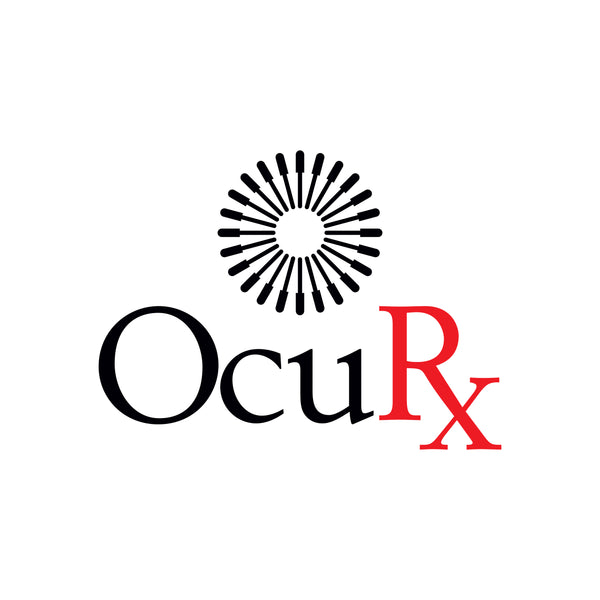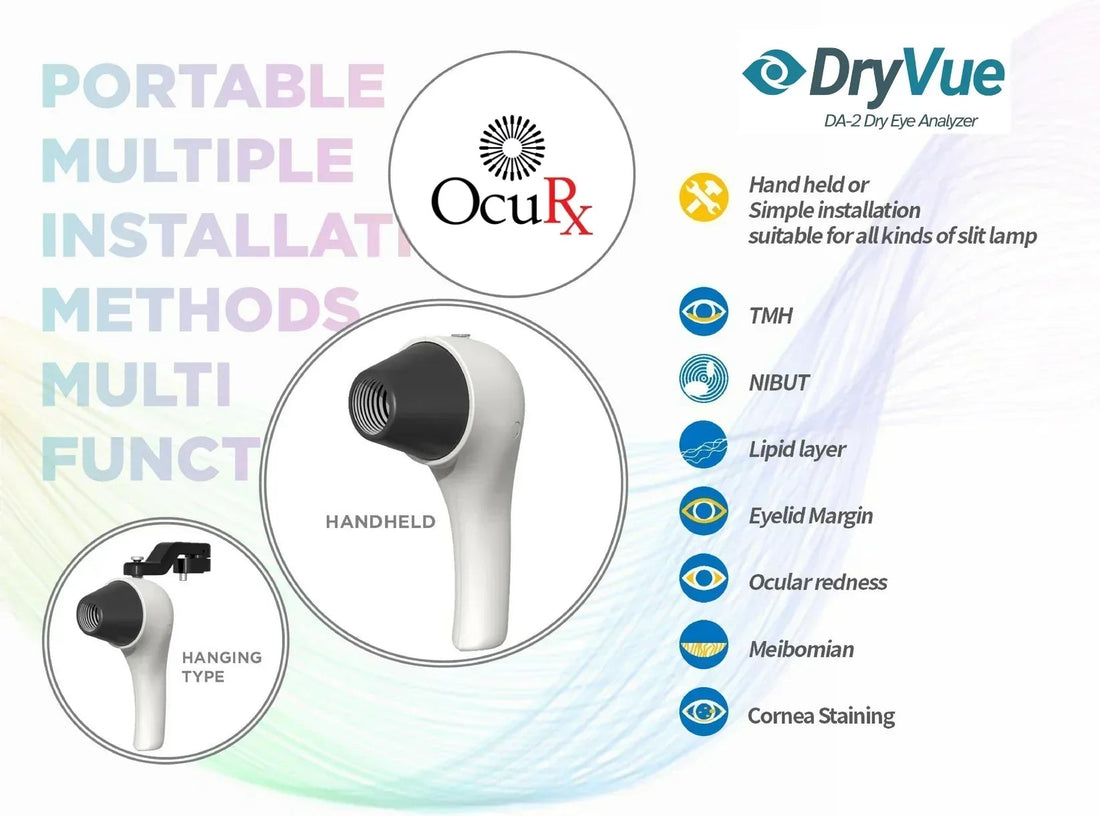How Optometry Practices Can Boost IPL and RF Treatment Conversions Using the DA-2 Dry Eye Analyzer from OcuRx
Dry eye disease (DED) affects millions of patients worldwide, with meibomian gland dysfunction (MGD) being a leading cause, contributing to approximately 86% of cases. Advanced treatments like Intense Pulsed Light (IPL) and Radiofrequency (RF) therapy have emerged as effective solutions for managing MGD-related dry eye by addressing inflammation and improving gland function. However, convincing patients to pursue these treatments can be challenging due to cost, lack of awareness, or uncertainty about their condition. By leveraging advanced diagnostic tools like the DA-2 Dry Eye Analyzer from OcuRx, optometry practices can enhance patient education, build trust, and significantly increase conversion rates for IPL and RF treatments. This article outlines strategies to achieve this, focusing on the role of diagnostics in driving patient commitment.
Understanding the DA-2 Dry Eye Analyzer
The DA-2 Dry Eye Analyzer from OcuRx is a cutting-edge diagnostic device designed to provide comprehensive, objective assessments of ocular surface health. It offers high-resolution imaging and quantitative analysis of the tear film, meibomian glands, and eyelid margins. Key features include:
- Meibomian Gland Imaging: Visualizes gland structure and identifies blockages or atrophy.
- Tear Film Analysis: Measures tear breakup time (TBUT) and lipid layer thickness to assess tear stability.
- Inflammation Detection: Identifies signs of ocular surface inflammation, such as telangiectasia or abnormal blood vessels.
- Patient-Friendly Reports: Generates clear, visual reports that help patients understand their condition.
These capabilities make the DA-2 Dry Eye Analyzer an invaluable tool for diagnosing MGD and tailoring treatment plans, positioning it as a cornerstone for promoting IPL and RF therapies. Practices can acquire the DA-2 Dry Eye Analyzer from OcuRx for $500 off using the coupon code DA500 at checkout on the official website: https://ocurx.com/products/ocurx-da-2-dry-eye-analyzer.
Strategies to Increase IPL and RF Treatment Conversions
1. Leverage DA-2 Dry Eye Analyzer for Precise Diagnosis
A precise diagnosis is the foundation of patient trust and treatment acceptance. The DA-2 Dry Eye Analyzer’s ability to provide detailed, objective data about MGD and dry eye severity helps optometrists clearly communicate the need for advanced treatments like IPL and RF. For example:
- Visual Evidence: Show patients high-resolution images of their meibomian glands, highlighting blockages or gland loss. This visual proof makes the condition tangible, increasing the likelihood of treatment acceptance.
- Quantifiable Metrics: Use TBUT and lipid layer thickness measurements to demonstrate tear film instability, linking it directly to their symptoms (e.g., burning, redness, or blurry vision).
- Inflammation Insights: Highlight inflammatory markers like telangiectasia, which IPL effectively targets by closing abnormal blood vessels, reducing inflammation, and improving gland function.
By presenting concrete evidence, the DA-2 Dry Eye Analyzer helps patients understand why IPL and RF are necessary, moving them from skepticism to confidence.
2. Educate Patients with Visual and Personalized Reports
Patient education is critical for treatment buy-in, especially for elective procedures like IPL and RF, which are often not covered by insurance. The DA-2 Dry Eye Analyzer’s user-friendly reports can be used to create a compelling narrative:
- Before-and-After Potential: Explain how IPL and RF can improve gland function and tear quality, using DA-2 Dry Eye Analyzer data as a baseline. For instance, show how IPL’s photothermolysis can reduce telangiectasia, while RF’s heat can melt gland blockages.
- Customized Treatment Plans: Tailor recommendations based on DA-2 Dry Eye Analyzer findings. For patients with severe MGD, emphasize the need for a series of 4–6 IPL/RF sessions, supported by studies showing significant improvement in meibum quality and symptom relief after multiple treatments.
- Visual Aids: Use DA-2 Dry Eye Analyzer images during consultations to make the condition relatable. For example, compare healthy versus dysfunctional glands, reinforcing the urgency of treatment.
By making the diagnosis visual and personalized, practices can bridge the gap between clinical findings and patient understanding, encouraging commitment to IPL and RF.
3. Build Trust Through Transparency
Trust is a key driver of treatment conversions. The DA-2 Dry Eye Analyzer’s objective data fosters transparency, helping patients feel confident in their diagnosis and treatment plan. Strategies include:
- Explain the Science: Use DA-2 Dry Eye Analyzer findings to explain how IPL targets inflammation and RF stimulates collagen production and gland function. Reference studies, such as those showing IPL-MGX improving tear breakup time in 87% of patients, to validate efficacy.
- Address Cost Concerns: Acknowledge that IPL and RF treatments, averaging $400–$700 per session, are an investment. Highlight long-term savings by reducing reliance on costly prescription drops ($2,000–$2,400 annually) and improving quality of life. Offer financing options like CareCredit or HSAs to make treatments accessible.
- Set Realistic Expectations: Use DA-2 Dry Eye Analyzer data to inform patients that significant relief often requires 3–4 sessions, with maintenance every 6–12 months. This honesty prevents disappointment and builds credibility.
Transparency, backed by DA-2 Dry Eye Analyzer diagnostics, reassures patients that their treatment plan is evidence-based and tailored to their needs.
4. Streamline the Patient Experience
A seamless patient experience enhances conversion rates. Integrate the DA-2 Dry Eye Analyzer into a structured dry eye evaluation process:
- Comprehensive Dry Eye Workup: Begin with a DA-2 Dry Eye Analyzer assessment during the initial consultation to establish a baseline. Combine with other tests, like the Ocular Surface Disease Index (OSDI) questionnaire, to correlate symptoms with clinical findings.
- Efficient Consultations: Use DA-2 Dry Eye Analyzer’s quick imaging (typically under 10 minutes) to keep appointments concise, respecting patients’ time while delivering thorough diagnostics.
- Follow-Up Monitoring: Schedule post-treatment DA-2 Dry Eye Analyzer evaluations to track improvements in gland function and tear stability. Share these results with patients to reinforce the value of IPL and RF, encouraging adherence to maintenance sessions.
A streamlined process, centered around the DA-2 Dry Eye Analyzer, makes patients feel cared for and confident in their treatment journey.
5. Market IPL and RF as a Premium Service
Positioning IPL and RF as premium, cutting-edge treatments can attract patients seeking advanced care. Use the DA-2 Dry Eye Analyzer to differentiate your practice:
- Highlight Technology: Promote the DA-2 Dry Eye Analyzer as a state-of-the-art diagnostic tool, emphasizing its role in delivering personalized care. For example, mention its use in conjunction with FDA-approved devices like Lumenis OptiLight for IPL.
- Showcase Success Stories: Share anonymized DA-2 Dry Eye Analyzer before-and-after images (with patient consent) on your website or in-office displays, illustrating improvements in gland health and symptom relief.
- Community Outreach: Host dry eye seminars or webinars, using DA-2 Dry Eye Analyzer data to educate potential patients about MGD and the benefits of IPL/RF. Offer free or discounted DA-2 Dry Eye Analyzer screenings to attract new patients.
By marketing IPL and RF as premium services, supported by advanced diagnostics, practices can expand their patient base and increase conversions.
6. Train Staff to Maximize DA-2 Dry Eye Analyzer Impact
Staff play a crucial role in patient education and conversion. Train your team to:
- Understand DA-2 Dry Eye Analyzer Outputs: Ensure technicians can explain DA-2 Dry Eye Analyzer reports in simple terms, reinforcing the doctor’s recommendations.
- Communicate Value: Equip staff to discuss the long-term benefits of IPL and RF, using DA-2 Dry Eye Analyzer data to justify the investment.
- Handle Objections: Train staff to address common concerns, such as cost or treatment duration, by referencing DA-2 Dry Eye Analyzer findings and clinical evidence.
A well-trained team amplifies the DA-2 Dry Eye Analyzer’s impact, creating a cohesive patient experience that drives treatment acceptance.
Addressing Challenges and Considerations
While the DA-2 Dry Eye Analyzer is a powerful tool, practices must address potential challenges:
- Patient Selection: IPL is most effective for Fitzpatrick skin types I–IV due to melanin absorption risks. Use DA-2 Dry Eye Analyzer to identify suitable candidates and recommend RF for darker skin tones, which is safer and effective for all skin types.
- Contraindications: Screen for contraindications (e.g., recent ocular surgery, photosensitive medications) using DA-2 Dry Eye Analyzer assessments and patient history to ensure safety.
- Cost Management: Be upfront about costs and offer payment plans to mitigate financial barriers. Use DA-2 Dry Eye Analyzer data to demonstrate value, comparing it to the ongoing expense of alternative treatments.
Conclusion
The DA-2 Dry Eye Analyzer from OcuRx empowers optometry practices to increase IPL and RF treatment conversions by providing precise, visual, and objective diagnostic data. By leveraging its capabilities for diagnosis, patient education, trust-building, and marketing, practices can effectively communicate the value of these advanced therapies. Strategies like personalized reports, transparent discussions, and a streamlined patient experience turn hesitant patients into committed ones, improving outcomes and practice growth. Practices can take advantage of a $500 discount on the DA-2 Dry Eye Analyzer by using the coupon code DA500 at checkout on https://ocurx.com/products/ocurx-da-2-dry-eye-analyzer, making it an accessible investment for enhancing dry eye care. As dry eye prevalence rises, adopting tools like the DA-2 Dry Eye Analyzer positions practices as leaders in innovative care, delivering lasting relief to patients while boosting revenue.

